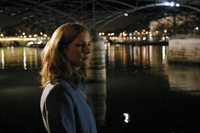Recalling Robert Bresson (in particular, Une Femme deuce) in its muted gesturality and Manoel de Oliveira in its saturated formalism, and infused with a dose of Raoul Ruiz’s puckish, tongue-in-cheek cerebral humor, the prevailing theme of Le Pont des Arts is perhaps best defined by a conversation that occurs early in the film between a computer scientist, Manuel (Alexis Loret) and his girlfriend, Sarah (Natacha Régnier) on defining baroque as the coexistence of two contradictory entities, both of which are simultaneously true. Manuel is quick to admit that the conceptual dichotomy evades him, a juxtaposition that implies the synthesis of bifurcated realities, even as he acknowledges a certain philosophical beauty behind the idea of it. But for the fragile and increasingly insecure Sarah, a talented, young classically trained mezzo-soprano studying the nuances of baroque performance under the tutelage of a cruel and vain, but highly influential impresario named Guigui (Denis Podalydès) (and whose own grotesque affectation and mercurial temperament have earned him the nickname “the unnamable” by his protégés), the silence of Manuel’s incomprehension only reinforces the intranscendable distance that separates them. Elsewhere, a similar gulf continues to deepen for another couple, Pascal (Adrien Michaux) an undermotivated graduate student who has grown increasingly uncertain over the desire to finish his prescribed thesis, and his ambitious girlfriend, a philosophy student Christine (Camille Carraz).
A understated, alternating point-of-view framing of a repeated near encounter between Pascal and a demoralized Sarah at a café (featuring another cameo appearance by Eugène Green as a bartender that the filmmaker first introduced in Toutes des nuits) provides a insightful glimpse of their interconnected destinies, an ephemeral kinship that is also reinforced in Pascal’s affinity for Michelangelo Buonarroti’s lesser known works of poetry that is paralleled in Sarah’s receipt of a similar book of poems as a Christmas gift from Manuel. It is interesting to note that Green’s illustration of the profound connection between Sarah and Pascal, alluded through the evocation of Michelangelo’s “lost art”, is also implicitly suggested in the placement of a Death in Venice soundtrack record album next to Sarah’s recording of Monteverdi’s Lamento della Ninfa during Pascal’s transformative moment of crisis (Thomas Mann’s novella contextually alludes to Michelangelo’s apparent obsession with the young man, “David” – who is generally considered to have served as the model and muse for his eponymous statue – that is reinforced in the image of young Tadzio’s iconic gesture against the seascape that is witnessed by Aschenbach). Moreover, in indirectly evoking Death in Venice – and, in particular, the image of an accomplished artist brought to self-destructive obsession over a desire for the unattainable (and elusive) – Green provides a framework, not only to introduce the idea of the liebestod (love and death), but also to illustrate the implicit moral corruption innate in leading a life of cerebrality and empty intellectualism (and more directly, abstract philosophy) without corporeality or creative instinctuality – a visceral intuitiveness towards the aesthetic beauty of a work of art without the arbitration (and obscurantism) of rote academic theory – a perversion of the Socratic method as a path of inquiry towards enlightenment represented by Guigui (a dysfunctional incarnation of a Socrates figure) in his exploitation of his obliging, young steward, Cédric (Jérémie Renier) that is similarly reflected in his colleague, Jean-Astolphe Méréville’s (Olivier Gourmet) nefarious, in-house “auditions” of young men, often street hustlers, whom he “discovers” by cruising the evening streets of Paris. It is this transparency and directness between the heart and mind in attaining enlightened beauty – the ideal of reaching the sublime by breaking free from the laws of logical thought – that is ultimately encapsulated in the transcendent and rapturous encounter between the star-crossed lovers on the momentous Bridge of Arts: an Orphic transfiguration that exists beyond the metaphysical realities of time and space, a convergence towards an eternal destiny forged by profound connection.
© Acquarello 2007. All rights reserved.
